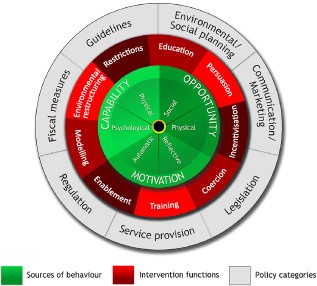For 10 consecutive years EMCOR Group, Inc., has been named amongst the Top 5 “World’s Most Admired” Companies and is ranked #1 “World’s Most Admired” in the Engineering and Construction Industry for 2018 by Fortune®. It prides itself in its forward thinking approach to creating “A Better World at Work”. This includes recognising and embracing the need to support employee wellbeing.
Jonathan Gawthrop is EMCOR (UK) Group’s Executive Director for Wellbeing, Sustainability and Assurance. He is also a member of the Make A Difference & MAD World Advisory Board. In this interview Jonathan shares tips on how he and the team approach structuring, communicating and measuring the impact of their employee wellbeing programme.
Your award-winning wellbeing strategy has been recognised for its authenticity. What are the core elements of the strategy?
We take a person-centric approach which is built around supporting all our teams in bringing their best selves to work. The themes of our strategy centre around psychological and physical safety and engaging with all employees in the creation of a wellbeing ”movement”. This is being done with cooperative design throughout the organisation.
Our strategy is also designed and being designed (because it will always be a work in progress) to support and develop our commitment to the Global Goals and in particular, Global Goals 8, Decent Work.
People Who Care is also one of our 4 core organisational values (alongside Safe & Secure, Together as One and Active & Ambitious). All of these have been built in support of delivery of our EMCOR UK Vision for “A Better World at Work”
How have you embedded sustainable behaviour change into this strategy?
We’re still doing it ????. We have taken the methodology of the Behaviour Change Wheel shown below, and used it to create systems mapping of our wellbeing activity.

Source: Michie, Atkins & West (2014)
By this I mean we have clearly identified who is doing what and where those departments and individuals have responsibility for effecting change. For example, clearly we have policy considerations – most recently a review and changes to our working from home policy in response to the pandemic effect.
Our HR department owns this activity in terms of discharging and control of the document. They also have significant input and influence in terms of content but there has been interface with the wellbeing team, the safety practioners and engagement with representation from affected employees.
This has resulted in a subsequent review of our IT charter which is being redesigned to actively support some of the challenges coming out of the policy review process. Built for employees by employees if you like.
Here communication of change is also critical. We do not rely upon an intranet for example. We use a whole range of available tools to make sure that all 4200 employees – be they part or full-time – receive the same message and have the same right of reply.
We work really hard at covering numerous channels as you would expect, from video to mail-out and drop- in sessions – both virtual and socially distanced. We use all mediums available at the time where we have been told by the recipients that they have most effect.
We have just stopped short of pigeons with notes tied to their legs…it’s a lot of work but essential in embedding change and making it sustainable and appropriate.
How are you measuring impact?
We have a number of methods currently in play including pulse surveys, lagging indicators such as absence and turnover rates. We also of course have data connected with elements of our EAP – for example around Financial Planning Assistance (how much money has been saved by our employees etc.)
We constantly look for anecdotal evidence and all our teams are encouraged to talk about how initiatives are affecting their teams. We undertook Britain’s Healthiest Workplace for the first time last year too and used a lot of that data to form our thinking.
But in respect of now and the work we are doing, our wellbeing metrics are designed to amplify the lagging indicators to answer your “so what” question. After all you can’t measure the morality of doing the right thing but doing the right thing itself and the parts of doing the right thing is what we are focusing our efforts on.
In short it’s output based. We can measure how many interventions we have delivered against our nutritional intervention target for example, knowing that nutrition is something our teams have a genuine interest and desire to be assisted with. We then measure the success or otherwise of the intervention through the pulse survey programme for example. That wraps up the feedback loop ready to recreate or move on.
What are your next plans for your wellbeing strategy and how are these being impacted by the unfolding pandemic?
The pandemic is dictating some of our activity as I’ve mentioned. Our next 6 months activity plan is built around supporting everyone in this area be they in work or working from home.
Recently we have focused upon some internal storytelling from EMCOR UK leaders in respect of their experiences and how they are affected by SAD. This was really brave and had a dramatic unifying effect with. A number of employees shared similar experiences.
In terms of other subjects, we are currently finalising our support for menopause in the workplace and expanding on out MHA (Mental Health Aware) programme. This is based on broadening awareness in respect of signposting in support of mental ill health.
Why is an authentic wellbeing strategy important and how do you achieve this authenticity?
If its not authentic what’s the point? Its probably more damaging to have a load of rhetoric around the subject and not do anything than not do anything at all.
Authenticity is critical. Its like the same discussion that we used to have around culture. You can’t necessarily explain it but you will recognise it when you see it. Because positive wellbeing for yourself and others is so vital to everything, it can’t be addressed in some half-baked manner; it’s all or nothing,
Vulnerability is at its core and with that comes authenticity. Treat others as you would want to be treated. Make mistakes of course but learn and don’t do anything to the detriment of others. Oh and share with others.
There is (or should be) no intellectual property around looking after people well. We are lucky to have a great network of colleagues, practitioners and experts who help share and inform. You know who you are thank you to you all ????.
In return we are happy to share our journey and learnings too in order to make workplace a better place or as we say “A Better World at Work”
What is one lesson that you’ve learned that you would like to share with employers who are just starting to devise employee mental health and wellbeing programmes?
I’ll give you two.
- First reach out. As I’ve just said, there are footprints to follow and everyone I meet is only to pleased to help – me included by the way.
- Second – on’t waste money on a fruit trolley…
Reference:
Michie, S., Atkins, L., & West (2014). The Behaviour Change Wheel A Guide to Designing Interventions. UK: Silverback Publishing.












